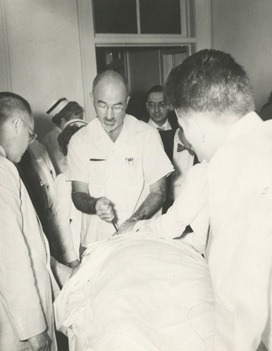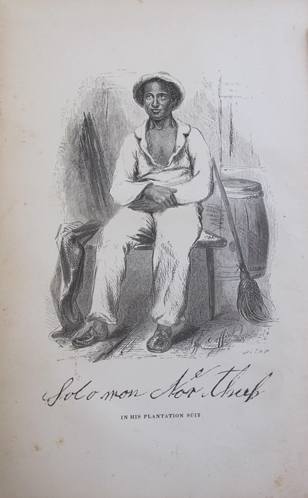Photo

Every day brings a fun find in the University Archives! In 1954 the Saturday Evening Post called GWU "Dr. Marvin's Genius Factory." The article featured a photo of young men in ties and young women in bobby socks, and described the student body as "dapper Continental savants, sweater girls from Kansas, and the offspring of Government bigwigs."
1 note
·
View note
Photo

Fun and games in Special Collections at Gelman! It turns out we own a child's puzzle from 1890. Clever kids could turn the 6-sided blocks to form the Smithsonian building (shown here); the Capitol; the White House; the Treasury Building; the War, State and Navy Building (now Old Executive Office Building); and the "New Congressional Library" (Library of Congress).
2 notes
·
View notes
Photo

This photo from Gelman Special Collections has a simple, descriptive title: Looking Northwest from Constitution Avenue, 1894. But how was it taken? We are clearly looking down from high above, along Virginia Avenue with the Aqueduct Bridge (now site of Key Bridge) in the distance. It's 1894, and there are no airplanes. Aerial photographers in the 19th century were creative, using balloons, kites, even pigeons to raise their cameras high. But given the location, this one seems to have a simpler solution: they were atop the Washington Monument, which was dedicated in 1885.
7 notes
·
View notes
Photo

MLB Opening Day is this Monday! Check out this cartoon from the "Opening of the League Season" back in 1895, featuring a dashing Washington Senator, from the papers of George Coffin, a well-known D.C. political cartoonist and GW alum. We have his papers (and a lot more old political cartoons) at the Special Collections Research Center. "Oh! My!" says the Victorian lady, "Ain't they just splendid?"
3 notes
·
View notes
Photo

Join us for this semester's last panel 'Go Team! Writing and Publishing in Collaborative Science' on Tuesday, April 1st from 1-2:30pm. Room 405 in the Marvin Center.
0 notes
Photo

Today's Interdisciplinary Publishing Panel on Autism and Neurodevelopmental Disorders.
0 notes
Photo

A researcher at Special Collections recently requested this great 1873 map of Washington, D.C., showing the buildings that had been constructed so far (in red). Looking north and east from the Capitol, it's remarkably empty to a modern eye -- no Library of Congress (built 1897), no Union Station (1907), no Supreme Court (1935). Just a city of broad avenues with blocks of open space. (See call no. G 3850 1873.E57)
0 notes
Text
January Collection of the Month: D.C. Front Runners records

Special Collections is pleased to announce the opening of the D.C. Front Runners records, a collection of photographs, newsletters, correspondence, race results, and membership and financial records documenting D.C.’s landmark running and social club for the LGBT community.
The D.C. Front Runners was founded in 1981 and is now one of dozens of Front Runners clubs in the United States and abroad. The first Front Runners organization was formed in San Francisco in 1978, as a running club with a name inspired by Patricia Nell Warren's novel The Front Runner. After over 30 years, the group continues to organize weekly walks and runs, sponsor local running events, arrange social events, and send runners to local and national races.
For more information on this collection, check out the finding aid and then come take a look at the collection here!
0 notes
Text
Wall Street Journal Reporter Uses Special Collections to Uncover the Dark History of Lobotomies at the VA

The Wall Street Journal has just published a groundbreaking series on the use of lobotomies by the US Department of Veterans Affairs (VA) on returned soldiers in the years following World War II. Reporter Michael Phillips combed through boxes of records at the National Archives and here in GW's Special Collections Research Center to uncover the story of the military's use of lobotomies to treat veterans suffering from PTSD and a host of other mental illnesses. Phillips found that the military, desperate for a way to help patients in the era before antipsychotic drugs, used procedures that were not uniformly accepted by the medical establishment. While some patients found relief from debilitating symptoms as a result of their lobotomies, others found their lives irrevocably damaged, or even died as a result of the procedure. The ramifications of these operations continue today for the survivors and their families.
View the Wall Street Journal's multimedia presentation of the story here: http://projects.wsj.com/lobotomyfiles/
The Special Collections Research Center houses the Walter Freeman and James Watts Papers. Walter Freeman, a professor of neurology at GW from 1926-1954, was a strong proponent of the use of lobotomy to treat mental illness. He developed a new transorbital technique for the procedure, and traveled the country demonstrating his technique and performing thousands of lobotomies on patients. Enthusiasm for the procedure in the medical community dramatically decreased in the 1950s as it became clearer that outcomes were mixed for patients and as new drugs came on the market that were able to treat mental illness in ways less permanent and damaging. Freeman was eventually banned from operating on patients in 1967 and died in 1972.
The Special Collections Research Center is proud to have supported this important research. We hope that scholars will continue to make use of the Walter Freeman and James Watts papers in exploring the history of mental health and psychiatric treatment in the United States.
0 notes
Text
Mapping D.C.'s Literary Life with "D.C. by the Book"
Want to explore, document, and have fun with D.C. fiction? Keep reading! The Special Collections Research Center is pleased to be joining the D.C. By the Bookproject. The project goal is to use crowdsourcing to highlight passages from the (largely undiscovered) rich body of literature set in D.C. that illuminate its social and geographic history. The website maps these passages and everyone learns more about D.C.’s literary life.
We need your help to find great passages of fiction that describe a particular location or evoke a neighborhood in Washington, D.C. This is a collaborative effort between librarians, experts in local fiction, local history organizations, and anyone interested in D.C.’s literary history. The project is supported by the Institute of Museum and Library Studies’ Library Services and Technology Act grant program.
Special Collections here at GW has a rich collection of D.C. Fiction. This bibliography is a list of all the D.C. fiction housed in Special Collections. Please feel free to visit us, request some fiction and start adding to the site at http://dcbythebook.org Come read cool stories and find amazing passages describing D.C. locations near you.
0 notes
Text
Rare Books Revealed: Hatchet Article Sheds Light on Origins of Some of Gelman’s Oldest Books

Did you know that Special Collections has books that are more than 500 years old? While some of these treasures have been purchased or donated in recent years, others have been in the library for a very, very long time and the story of how they came to be here is unclear.
Recently, we found a Hatchet article that sheds some light on the origins of some of our oldest books. The October 29, 1930 article, titled “G.W. University Library Houses a Rare Collection,” describes how the Baptist clergymen who founded GW (then known as Columbian College) donated rare religious books after the school opened in 1821, forming the nucleus of our present-day library collections.
There are three specific books described in the article: the “Polyglot Psalter,” a 1516 triumph of printing and scholarship printed in multiple languages, containing one of the earliest descriptions of Christopher Columbus; a 1519 edition of the works of Claudius; and a 1543 first edition of a work on Moses by Martin Luther, printed in Wittenberg by Peter Seitz.
The books were printed nearly five hundred years ago and donated nearly two hundred years ago. We’re proud to report that each of these books is still housed in Special Collections today! They reside in our vault, a high security location for our most treasured items, but are available for you to use whether it’s research or curiosity that leads you to them. The university’s founders would no doubt be pleased that, centuries later, their donations are still here benefiting GW’s students and scholars.
0 notes
Text
November Collection of the Month: Chauncey M. Depew Papers, 1856-1934

Have you heard of this 19th century orator, senator, lawyer, and railroad mogul? The Chauncey M. Depew papers are a hidden gem here at Special Collections, received by the university back in 1929 when Depew’s widow also endowed the professorship here that still bears his name.
Depew first gained fame as an orator while campaigning for Abraham Lincoln in 1860. Over the course of his career he was Secretary of State, counsel for and then president of the New York Central Railroad, then chairman of the board of directors of the Vanderbilt system of railroads, and ultimately a U.S. Senator from New York.
This collection contains fifty boxes of material documenting Depew's career in public speaking from approximately 1880-1920. It features handwritten and typescript speeches and notes, in addition to scrapbooks, memorial books, clippings, and photographs, as well as correspondence with such luminaries as Mark Twain, Harry Houdini, John D. Rockefeller, William Vanderbilt, and many U.S. Presidents. Come take a look at this collection to see what this turn-of-the-century VIP was writing and speaking about in his time.
Please browse the finding aid for the Chauncey M. Depew Papers here: http://library.gwu.edu/ead/ms2095.xml
0 notes
Text
Twelve Years A Slave: See the First Edition in Special Collections

With the recent release of the movie Twelve Years a Slave, Americans are learning the story of Solomon Northup, a free black man who was kidnapped into slavery in 1841. Northup survived a dozen years of slavery, being sold from owner to owner in Louisiana before friends in New York finally learned of his whereabouts and were able to secure his relase. In 1853, the same year he was freed, Northup published Twelve Years a Slave, his gripping account of these years. The book is especially important for scholars studying slavery in the District of Columbia, because it provides a firsthand description of slave markets in the District.
A first edition copy of this work is available in Special Collections for researchers. We welcome anyone interested in seeing the original publication to visit us on the seventh floor of Gelman Library.
0 notes
Photo

You asked, we answered. Newly designated graduate student study space in Gelman 503 opening 1/13/2014. #gwu #gwlibraries #gelmagram #gelmanlibrary #raisehigh
1 note
·
View note
Photo

Fun stuff happening on Kogan today! #gwu #gwlibraries #gelmagram #raisehigh
0 notes
Photo

'Churchill and the Presidents'-30th Internation Churchill Conference at the Marvin Center. #gwu #raisehigh #marvincenter #churchill
0 notes
Photo

Churchill and FDR. Lots of laughs during this talk -- history can be fun! #gwu #churchill #raisehigh #marvincenter
0 notes